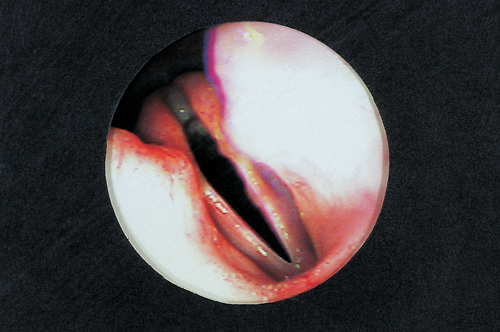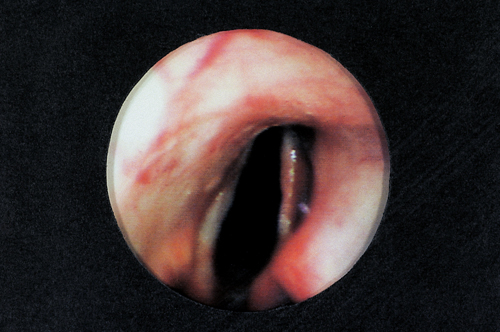Difference between revisions of "Small Animal Soft Tissue Surgery Q&A 22"
Ggaitskell (talk | contribs) |
|||
| (4 intermediate revisions by 2 users not shown) | |||
| Line 1: | Line 1: | ||
| + | {{Template:Manson | ||
| + | |book = Small Animal Soft Tissue Surgery Q&A}} | ||
| + | |||
| + | |||
[[Image:Soft Tissue Sx 22a.jpg|centre|500px]] | [[Image:Soft Tissue Sx 22a.jpg|centre|500px]] | ||
<br> | <br> | ||
| Line 6: | Line 10: | ||
<br /> | <br /> | ||
| − | ''' | + | '''The top photo is an intraoral endoscopic picture of an eight-year-old, spayed female Labrador Retriever that presented to the emergency clinic for dyspnea. The owners reported an acute onset of respiratory distress; upon further questioning, you learn that the dog has also had a change in her bark and she seemed to have respiratory difficulties last summer as well.''' |
<br /> | <br /> | ||
| Line 18: | Line 22: | ||
Clinical signs include voice change; gagging or coughing while eating; inspiratory stridor; and dyspnea, cyanosis or even syncope. | Clinical signs include voice change; gagging or coughing while eating; inspiratory stridor; and dyspnea, cyanosis or even syncope. | ||
| − | |l1= | + | |l1=Laryngeal Paralysis |
|q2=How will you confirm the diagnosis? | |q2=How will you confirm the diagnosis? | ||
|a2= | |a2= | ||
| Line 24: | Line 28: | ||
Cervical and thoracic radiographs are made to rule out other possible respiratory diseases. | Cervical and thoracic radiographs are made to rule out other possible respiratory diseases. | ||
| − | |l2= | + | |l2=Laryngeal Paralysis#Diagnosis |
| − | |q3=Name three surgical procedures that can be used to correct this problem and what complications might be encountered with each? | + | |q3=Name three surgical procedures that can be used to correct this problem and what complications might be encountered with each? The bottom photo is a postoperative intraoral endoscopic view of this animal. |
|a3= | |a3= | ||
Three surgical procedures are: | Three surgical procedures are: | ||
| − | *Unilateral arytenoid lateralization. Variations of this procedure include thyroarytenoid and cricoarytenoid cartilage lateralization. The most common complications are aspiration pneumonia and postoperative edema or hematoma. It is | + | *Unilateral arytenoid lateralization. Variations of this procedure include thyroarytenoid and cricoarytenoid cartilage lateralization. The most common complications are aspiration pneumonia and postoperative edema or hematoma. It is possible to penetrate the laryngeal mucosa during dissection, contaminating the surgical field from the oral cavity and risking abscess formation at the surgical site. In this author’s opinion (N.J.H. Sharp), this technique is the treatment of choice. |
*Partial laryngectomy is performed per os after temporary tracheostomy intubation (this allows unencumbered visualization of the pharynx). Hemorrhage and subsequent aspiration of blood can occur with this procedure, and swelling and edema may lead to airway obstruction. Aspiration pneumonia can occur if too much of the larynx is excised and the epiglottis is incapable of covering the airway. The most severe complication is laryngeal webbing and stenosis weeks to months after surgery. | *Partial laryngectomy is performed per os after temporary tracheostomy intubation (this allows unencumbered visualization of the pharynx). Hemorrhage and subsequent aspiration of blood can occur with this procedure, and swelling and edema may lead to airway obstruction. Aspiration pneumonia can occur if too much of the larynx is excised and the epiglottis is incapable of covering the airway. The most severe complication is laryngeal webbing and stenosis weeks to months after surgery. | ||
| − | *Castellated laryngofissure widens the lumen of the glottis by apposition of a | + | *Castellated laryngofissure widens the lumen of the glottis by apposition of a stair-stepped incision in the thyroid cartilage. The vocal folds are also resected and mattress sutures are placed through the arytenoid and thyroid cartilages to stabilize the arytenoid cartilages. Tracheostomy is recommended prior to this procedure. Complications reported include edema, aspiration pneumonia and stenosis at the surgery site. |
| − | |l3= | + | |l3=Laryngeal Paralysis#Treatment |
</FlashCard> | </FlashCard> | ||
| + | {{#tag:imagemap|Image:Next Question.png{{!}}center{{!}}200px | ||
| + | rect 0 0 860 850 [[Small Animal Soft Tissue Surgery Q&A 01]] | ||
| + | desc none}} | ||
[[Category:Small Animal Soft Tissue Surgery Q&A]] | [[Category:Small Animal Soft Tissue Surgery Q&A]] | ||
Latest revision as of 20:41, 23 October 2011
| This question was provided by Manson Publishing as part of the OVAL Project. See more Small Animal Soft Tissue Surgery Q&A. |
The top photo is an intraoral endoscopic picture of an eight-year-old, spayed female Labrador Retriever that presented to the emergency clinic for dyspnea. The owners reported an acute onset of respiratory distress; upon further questioning, you learn that the dog has also had a change in her bark and she seemed to have respiratory difficulties last summer as well.
| Question | Answer | Article | |
| Based on the history and illustration, what is your preliminary diagnosis? | Laryngeal paralysis. Idiopathic laryngeal paralysis is usually seen in large-breed dogs (Retrievers, Saint Bernard, and Siberian Husky) over nine years of age. Other etiologies include trauma, hypothyroidism and congenital paralysis. Clinical signs include voice change; gagging or coughing while eating; inspiratory stridor; and dyspnea, cyanosis or even syncope. |
Link to Article | |
| How will you confirm the diagnosis? | Diagnosis is by laryngoscopic observation of the arytenoids under sedation light enough that the gag reflex remains present. Failure of the arytenoid cartilages to abduct during inspiration or cough is diagnostic. Cervical and thoracic radiographs are made to rule out other possible respiratory diseases. |
Link to Article | |
| Name three surgical procedures that can be used to correct this problem and what complications might be encountered with each? The bottom photo is a postoperative intraoral endoscopic view of this animal. | Three surgical procedures are:
|
Link to Article | |

